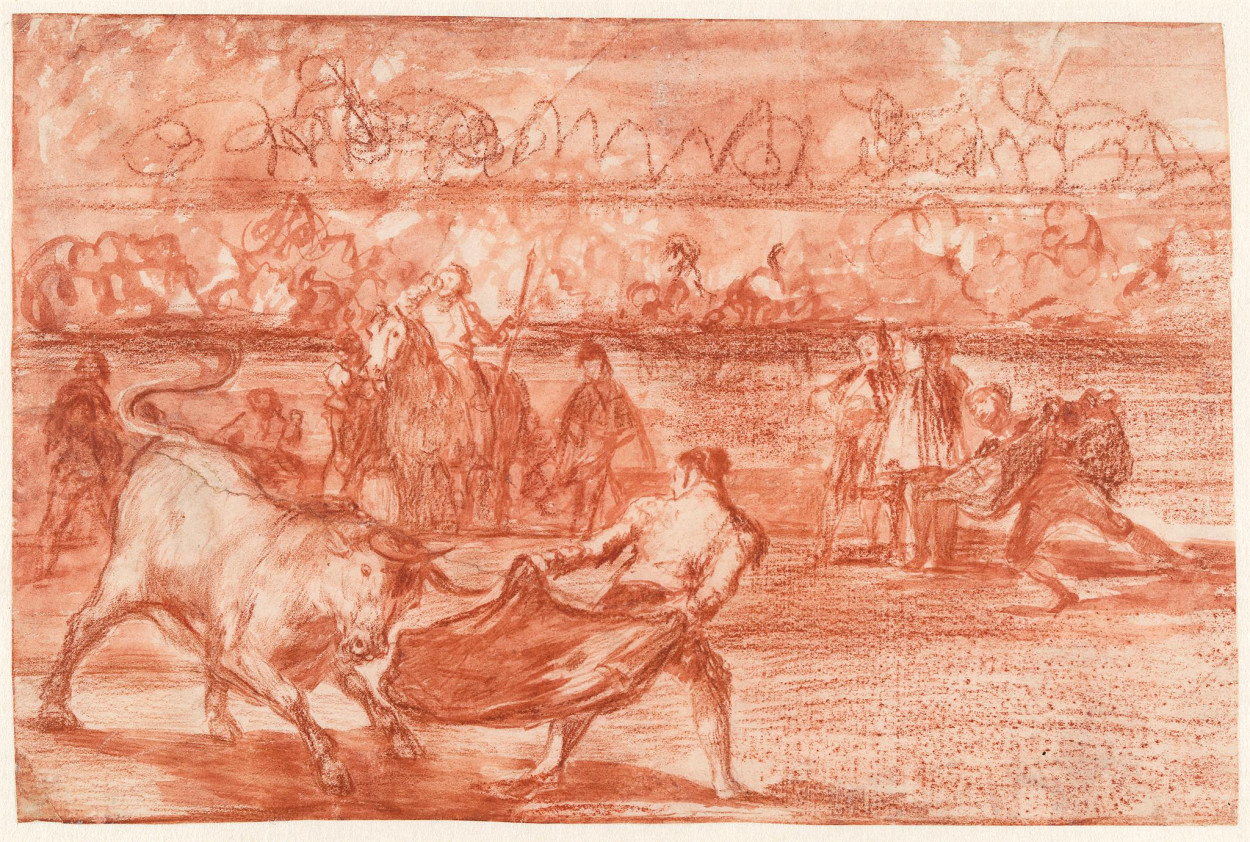
Francisco José de Goya y Lucientes, Zeichner
Mit dem Rücken zum Stier reizt ein Stierkämpfer diesen mit der Capa (Studie zur "Tauromaquia"), 1814 - 1816
This is a preparatory drawing for an engraving with only one surviving print: a trial proof with aquatint (Madrid, Biblioteca Nacional, inv. 45683) from the Valentín Carderera Collection. A study of that print reveals imperfections in the engraving of the bull, whose incorrect anatomy may have been Francisco de Goya's reason for rejecting it and almost certainly destroying its copper plate. As with other drawings from this series, the differences with the print appear fundamentally in the secondary figures. In the drawing, Goya confidently sketched the protagonists, the bullfighter passing the bull from the back and the bull charging his cape, and registered the retinues in the middle ground: on the right, a figure running to meet the bull with a cape and two others standing still and conversing while, on the left, a picador stands, flanked by two assistants. The depiction of the background sets the edge of the burladero surprisingly low, and the spectators are resolved with a few quick and very summary lines. The foreground figures remain the same in the print, but the rest of the composition is considerably modified. The group on the right becomes a pair holding an extended cape al alimón[1]* with smiling bullfighters behind them. And on the left, the previously upright picador seems to be dismounting a wounded horse that can barely stand, imbuing this image with a degree of drama characteristic of these bullfighting prints and largely motivated by the representation of the spectators, who are barely sketched in with rapidly etched lines and almost always in a somber atmosphere.
In his treatise, Pepe-Hillo describes the passes depicted by Goya: "Passes can also be carried out by two, holding the cape by its corners: the charm of this pass is never to let go of the cape, and to make the bull charge through the middle."[2] In that same edition of his treatise, Pepe-Hillo mentions passing from behind, which is one of the most interesting ways of using the cape. Its practice is very straightforward: the bullfighter stands with his back to the bull, presenting the cape from the rear and making certain he holds his arms out so that he can pass the bull without overly exposing his own body to its charge, or by twisting, and then he rapidly spins around on his feet so he is ready to repeat the pass from the other side. Our Delgado, who is supposed to have invented this pass, summons the bull with the greatest seriousness, and such a pass can only be carried out with the clearest and most buoyant fighting bulls, and only when they are sufficiently vigorous and agile; never with any other sort of bull, because, obviously, that would put him at risk."[3]
José Manuel Matilla
1 Trans. Note: An al alimón pass involves two bullfighters holding a single cape, as is described further on in the present text by Pepe-Hillo.
2 José Delgado “Pepe-Hillo," Tauromaquia o arte de torear a caballo y a pie: obra escrita por el celebre profesor Josef Delgado (vulgo) Hillo. Corregida y aumentada con una noticia histórica sobre el origen de las fiestas de toros en España. Adornada con treinta láminas que representan las principales suertes. Por un aficionado. Madrid, imprenta de Vega y Compania, 1804, 67, note 1.
3 Ibid., 64.
